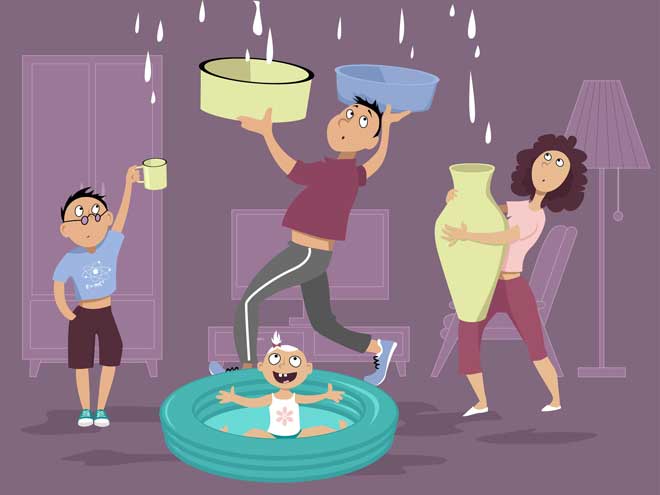We all know the phrase ‘when it rains, it pours’, but in some cases this can be more literal than we might imagine. If bad weather wasn’t enough, it can be a complete misfortune to see that water now dripping through your ceiling too. When you are hit with this situation, here is what you have to do.

1. Minimise the damage
Minimise the damage which the dripping water can make by removing any valuables and electronic devices from the splash zone.
Anything which is too heavy to be moved should be covered in a waterproof sheet, or something like a bin bag in order to prevent your furniture getting water damaged.
2. Contain the leaking water
Once you have cleared the area, place a container or a vessel underneath the leak to catch the water. If it is falling from a great height, it may splash onto the floor around the bowl or bucket, so it may be good to place the container on an old tea towel.
Now that you have the leak under control, it is time to call in a professional roofer to find the root of the problem.
3. Call a professional roofer
Admittedly, there are many guides out there to help you find the leak yourself. However, when it comes to inspecting the external surfaces, it is always best to call in a professional roofer. These specialists will be able to inspect your Durham roofing, and assess the damage.
By calling in a professional, you are ensuring that all safety precautions are taken. Professionals will always use the necessary safety equipment and the latest gear. After all, you never know how bad the damage might be under the surface.
In the future, it is recommended that you check your roof twice a year for any kind of damage. This way you can take preventative measures, rather than having to fix a leak when it occurs.
4. Dry everything out
When water dries it can leave brown stains and water damage behind. The quicker you get your carpets and upholstery dry, the less likely they are to become ruined by the leak in your home.
Not only this, but if it is not dried out thoroughly, the excess water can encourage the growth of mould in your home. Over time, mould can begin to cause health problems for the occupants of the building.
5. Make sure your roof is future proof
After the threat of danger has gone, it might be time to breathe a sigh of relief! However, it is also important to make sure that your newly repaired roof can stand the test of time.
You can give it the best chance by regularly trimming nearby trees, making sure stray branches don’t knock your tiles; checking the flashing, which is often overlooked when trying to spot a leak; and potentially investing in a new roof, depending on the extent of the damage.
With all this in mind, you are good to go, and you will know what to do in a roofing emergency. Just remember, when in doubt, always call a professional.


Leave a Comment